Question
 jan.1st
jan.1st
Can you possibly tell me what to look for to see what sex is my dragon and round about how long they should be with what ages? also can you tell me are they supposed to look like they shedding? I have a photo. send me your e-mail so I can send it to you.
AnswerHi Jopetia,
Generally, its almost impossible to be certain until they are 18-24 months. There are "little" things that can give you hints when they are younger... Here is a link to things to look for:
http://www.triciaswaterdragon.com/sex.htm In looking at your dragons picture, he is to small/young to even begin to guess yet.
As to size.... that depends on the care they receive. When something is lacking in their care, they will be smaller than they should be. A well cared for CWD will be about 24 inches at about 24 months of age. I'm including a good link to more care info and I've typed out some basic, but vital info on their care. Here is a chart that you can get an idea as to age/size
http://www.triciaswaterdragon.com/age.htm
When they are getting ready to shed, they will take on a dusty appearance...some will look dull white or gray. Again, in the picture its tough to see as the picture is very small.
A very good site for water dragon care can be found at: http://www.triciaswaterdragon.com/dragoncr.htm (Although a little outdated on uvb info there)
Recommended terrarium size, length of 6 ft. The height, at least 4 ft. Depth 3ft.
With the water dragon, you will need to provide an area of uvb for him/her. They need to have the uvb to be able to process the calcium in the foods they eat. Without it, they will develop metabolic bone disease. There is more on this in the care sheet. The uvb info there is a bit out dated so here is some more information on proper uvb. Please don't let it confuse you!!
LIGHTING:
Supplying uvb can be done in a few ways. By special lights that come in fluorescent tubes or special screw in bulbs (mercury vapor)that are designed to produce uvb and heat. The tubes do not produce heat. UVB is needed by the Iguanas to be able to absorb the calcium in the foods they eat. With out the uvb, they will develop metabolic bone disease. There are tubes that say ''full spectrum'' but they do not produce any uvb.With the correct tubes, they must say that they produce BOTH uvb and uva. The uvb needs to be 5% or higher. Repti Sun 10.0 and the Repti Glo 8.0's are a great source for uvb. The old "favorites" are the repti sun 5.0 or the iguana light..which are the same tube, just different package. These need to be positioned 6-8 inches over the reptile for the 5% and 8% and 8-10 inches for the 10% so that they get the uvb that is needed. The tubes need to be replaced every 6-9 months as that they stop producing UVB long before they stop producing light.Using a fixture that 3 feet in length will provide adequate uvb for your CWD. You do not want to use compact uvb lights, both the spiral/coil type and the ones that look like long "U's" laying on their side and a few other brands are causing what basically amounts to snow blindness in reptiles and some do not provide the UVB in a direction that is needed for your lizard. To read more on this, you can go to http://www.uvguide.co.uk/index.htm
This link will take you to my discussion group and to a post that tells how to tell the new compacts from the old ones. http://pets.groups.yahoo.com/group/UVB_Meter_Owners/message/6721
Even though you may not be able to use the following light,I want to give you some information on it.
On the mercury vapor , they also produce heat. They also produce the uvb and uva. The best on the market now are the Mega Rays.(http://www.reptileuv.com) The distance from these are greater than the uvb tubes and the directions must be followed that are listed for the light. When using the mercury vapor lights, you don't need to have one light for uvb and one for heat. The Mercury vapor lights provide both.
For daytime heat, if using the tube uvb, regular household incandescent light bulbs produce heat. I like the halogen bulbs as they produce a nice bright light for your CWD. The wattage will
depend on the size of your reptiles enclosure. and the room temperature.Of course, the best uvb is from the sun and if you are in an area that you are able to take your CWD outside in a proper enclosure, (Never a tank or enclosed, solid cage)
The dragon will also need a basking area which has the uvb lighting and a temperature gradient of 84-88F. This temperature range in one area of the cage is needed so that they are able to properly digest their foods. Basically, with the heat light and uvb, we are recreating what the sun does for them in the wild. If your cage is getting too warm overall, you may be able to just use the uvb tubes or possibly the uvb tubes and a low wattage light bulb. Of course if it gets too hot overall, you will have to use a fan to move the air around, especially if it is a solid structure and not a mesh type cage. If a solid structure, be sure to add at least two areas of vents...one up high and another down low on the opposite end for air circulation.
Be sure to provide a pool of water for your dragon.
With gut loading the insects, be sure to use healthy foods to gut load them. Dark leafy greens, non sugar coated cereals, or even chicken feed works well. Of course there are products out there to gut load insects BUT those that are the gel form do nothing to add nutrition to the insects. If the insects aren't well fed, they have no nutrition for your dragon.
As to adding a Calcium supplement and vitamin supplement.... It doesn't hurt to add these a few times a week. You want to use a calcium that has no added Phosphorus. The better fed your insects are, the less your dragon will need supplemented, of course it will depend on your dragons health. I also want to mention that even though many dragons want nothing to eat other than insects, do offer dark leafy greens, various chopped vegetables and fruits. Some enjoy eating those foods, even if on occasion.


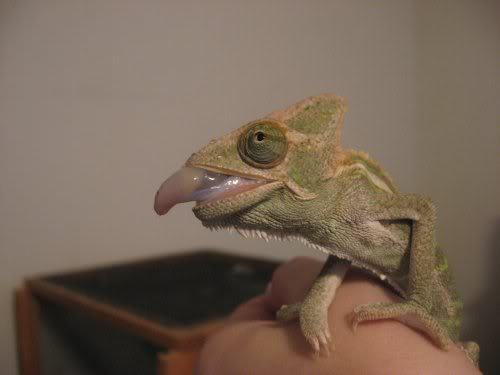 please help our chameleons tongue is very swollen
Questionpicture of swollen cam
QUESTION: about 2
please help our chameleons tongue is very swollen
Questionpicture of swollen cam
QUESTION: about 2
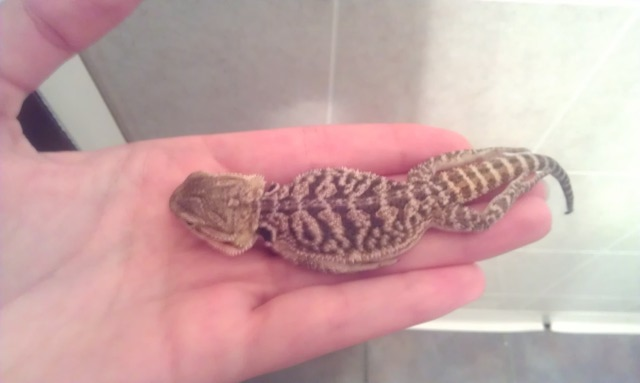 Sick Baby Beardie?
Question
Baby
I just purchased a baby Bearded Dr
Sick Baby Beardie?
Question
Baby
I just purchased a baby Bearded Dr
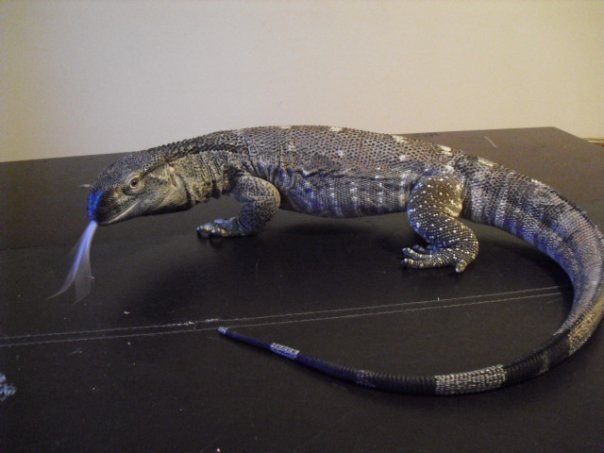 Is salt water ok?
QuestionQUESTION: Hi, Im moving to the coast in a coupl
Is salt water ok?
QuestionQUESTION: Hi, Im moving to the coast in a coupl
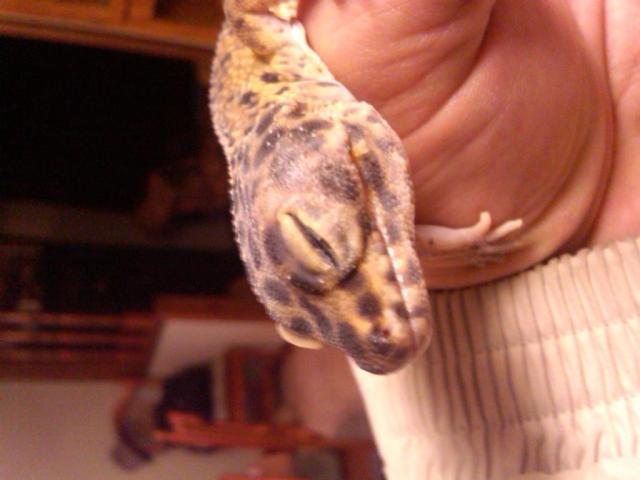 Leopard Gecko with swollen left
QuestionQUESTION: Hello Tracie,
I have a Leopard Gecko
Leopard Gecko with swollen left
QuestionQUESTION: Hello Tracie,
I have a Leopard Gecko
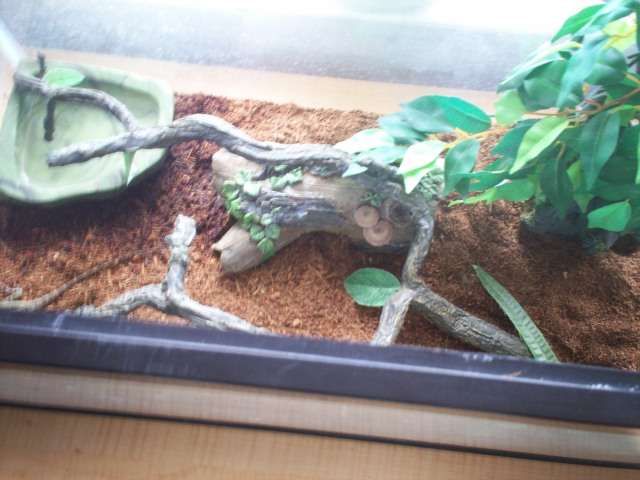 horned mountain lizard
Question
Bandit the horned moun
hi I have questio
horned mountain lizard
Question
Bandit the horned moun
hi I have questio